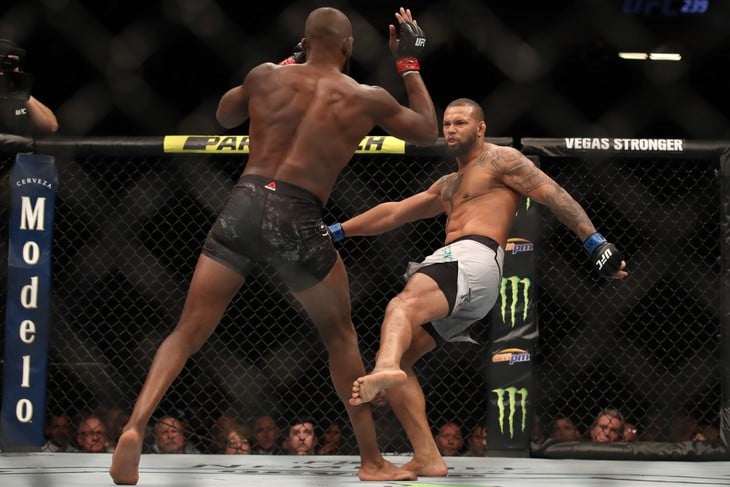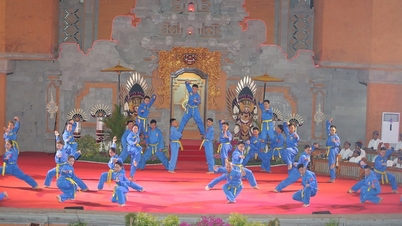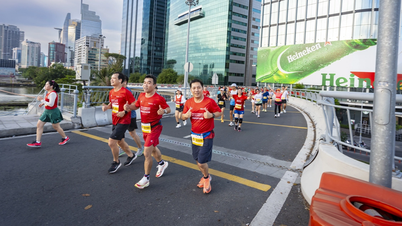
Low kicks are highly valued in the professional ring - Photo: YK
While kicks aimed at the head often produce spectacular knockouts, experts agree that leg kicks (leg kicks, low kicks, or calf kicks) are the most effective and formidable weapons in real combat.
According to MMA and kickboxing coaches and technical analysts, the leg kick is not only powerful in its impact, but more importantly, it has a direct impact on the opponent's mobility and defense.
When the thigh or calf is hit repeatedly, the large nerves and muscles in this area swell, causing the person being hit to gradually lose balance, lose their jumping ability, and no longer have enough strength to counterattack.
“The leg kick doesn't knock someone out, but it wears them out and paralyzes their entire motor system,” coach Firas Zahabi, who once trained Georges St-Pierre, explains in his podcast on MMA tactics.
Professional fighters call this “victory by attrition.” A fighter who loses his mobility will be cornered, unable to dodge punches or high kicks.
In a UFC fight in Argentina in 2018, Santiago Ponzinibbio left Neil Magny almost unsteady after just two rounds with a series of leg kicks, before finishing him off with a knockout punch in the fourth round.
Previously, at UFC 86, Forrest Griffin also used a similar method to weaken Rampage Jackson - a boxer famous for his physical strength and jumping power - with dozens of kicks to the thigh.
Not only in MMA, but also in Muay Thai and kickboxing - two disciplines with a long tradition of kicking techniques - leg kick is always considered a key tactical move.
Former kickboxing champion Bas Rutten once said: “A good kick to the thigh makes your opponent not want to fight anymore. You don't need to knock them out, just make them unable to stand.”
According to the training materials of the Dutch Kickboxing Federation, the lateral quadriceps is a classic weak point, because it is home to many sensory nerves and weight-bearing muscles.
The pillar-breaking kick is also considered the most practical move because it is easy to apply in real life. Not requiring long distance or special flexibility like a kick to the head, the pillar-breaking kick can be thrown in close range, suitable even for amateurs.
Self-defense experts at the Krav Maga Institute (Israel) consider the post-breaking kick to be an “effective move to prevent the opponent from approaching”, because it forces the attacked person to kneel or reduce speed, creating time for the defender to escape or counterattack.
Of course, leg kicks are not without risk. If executed at the wrong angle or without a decoy, the kicker can easily be caught or countered.
The 2021 fight between Chris Weidman and Uriah Hall is a classic example: Weidman broke his shin bone right after a kick was blocked properly. Therefore, modern coaches emphasize the “setup” factor - combining punches or feints to make the opponent unable to react.

Pillar-breaking kicks appear continuously in every match - Photo: PL
In recent years, a variation of the leg kick called the calf kick - which targets the lower calf - has become popular in the UFC.
This move has a small amplitude, is unpredictable and causes a quick numbing effect because this area contains many superficial nerves. Technical analyst Robin Black of TSN (Canada) said that the calf kick is “a game-changer because it damages mobility after just a few hits.”
As modern martial arts became more practical and effective, the flashy kicks gave way to short, precise strikes that were more likely to “break the rhythm of the fight.”
The post-kick – simple but effective – is emblematic of that trend. It doesn’t get the crowd cheering right away, but in the eyes of experts, it’s a game-changer more than any knockout.
Source: https://tuoitre.vn/don-da-nao-loi-hai-nhat-tren-vo-dai-chuyen-nghiep-2025111210450257.htm







![[Photo] Highways passing through Dong Nai](https://vphoto.vietnam.vn/thumb/1200x675/vietnam/resource/IMAGE/2025/11/12/1762940149627_ndo_br_1-resize-5756-jpg.webp)































































































![Dong Nai OCOP transition: [Article 3] Linking tourism with OCOP product consumption](https://vphoto.vietnam.vn/thumb/402x226/vietnam/resource/IMAGE/2025/11/10/1762739199309_1324-2740-7_n-162543_981.jpeg)








Comment (0)